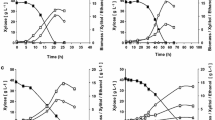Summary
The kinetics and enzymology of d-xylose utilization were studied in aerobic and anaerobic batch cultures of the facultatively fermentative yeasts Candida utilis, Pachysolen tannophilus, and Pichia stipitis. These yeasts did not produce ethanol under aerobic conditions. When shifted to anaerobiosis cultures of C. utilis did not show fermentation of xylose; in Pa. tannophilus a very low rate of ethanol formation was apparent, whereas with Pi. stipitis rapid fermentation of xylose occurred. The different behaviour of these yeasts ist most probably explained by differences in the nature of the initial steps of xylose metabolism: in C. utilis xylose is metabolized via an NADPH-dependent xylose reductase and an NAD+-linked xylitol dehydrogenase. As a consequence, conversion of xylose to ethanol by C. utilis leads to an overproduction of NADH which blocks metabolic activity in the absence of oxygen. In Pa. tannophilus and Pi. stipitis, however, apart from an NADPH-linked xylose reductase also an NADH-linked xylose reductase was present. Apparently xylose metabolism via the NADH-dependent reductase circumvents the imbalance of the NAD+/NADH redox system, thus allowing fermentation of xylose to ethanol under anaerobic conditions. The finding that the rate of xylose fermentation in Pa. tannophilus and Pi. stipitis corresponds with the activity of the NADH-linked xylose reductase activity is in line with this hypothesis. Furthermore, a comparative study with various xylose-assimilating yeasts showed that significant alcoholic fermentation of xylose only occurred in those organisms which possessed NADH-linked aldose reductase.
Similar content being viewed by others
References
Barnett JA, Payne RW, Yarrow D (1979) A guide to identifying and classifying yeasts. Cambridge University Press, London
Bruinenberg PM, van Dijken JP, Scheffers WA (1983a) A theoretical analysis of NADPH production and consumption in yeasts. J Gen Microbiol 129:953–964
Bruinenberg PM, van Dijken JP, Scheffers WA (1983b) An enzymic analysis of NADPH production and consumption in Candida utilis. J Gen Microbiol 129:965–971
Bruinenberg PM, de Bot PHM, van Dijken JP, Scheffers WA (1983c) The role of redox balances in the anaerobic fermentation of xylose by yeasts. Eur J Appl Microbiol Biotechnol 18:287–292
Debus D, Methner H, Schulze D, Dellweg H (1983) Fermentation of xylose with the yeast Pachysolen tannophilus. Eur J Appl Microbiol Biotechnol 17:287–291
Dekker RFH (1982) Ethanol production from D-xylose and other sugars by the yeast Pachysolen tannophilus. Biotechnol Lett 4:411–416
Dellweg H, Debus D, Methner H, Schulze D, Saschewag I (1982) Xylose-Vergärung mit Pachysolen tannophilus. In: Dellweg H (ed) 5. Symposium Technische Mikrobiologie, Berlin. Inst Gärungsgewerbe u Biotechnol, Berlin, pp 200–207
Du Preez JC, van der Walt JP (1983) Fermentation of d-xylose to ethanol by a strain of Candida shehatae. Biotechnol Lett 5:357–362
Herbert D, Phipps PJ, Strange RE (1971) Chemical analysis of microbial cells. In: Norris JR, Ribbons DW (eds) Meth microbiol 5B. Academic Press, London New York, pp 209–344
Jeffries TW (1981) Conversion of xylose to ethanol under aerobic conditions by Candida tropicalis. Biotechnol Lett 3:213–218
Jeffries TW (1983) Utilization of xylose by bacteria, yeasts, and fungi. Adv Biochem Engin Biotechnol 27:1–32
Kurtzman CP (1983) Biology and physiology of the D-xylose fermenting yeast Pachysolen tannophilus. Adv Biochem Engin Biotechnol 27:73–83
Maleszka R, Neirinck LG, James AP, Rutten H, Schneider H (1983) Xylitol dehydrogenase mutants of Pachysolen tannophilus and the role of xylitol in D-xylose catabolism. FEMS Microbiol Lett 17:227–229
Margaritis A, Bajpai P (1982) Direct fermentation of D-xylose to ethanol by Kluyveromyces marxianus strains. Appl Environ Microbiol 44:1039–1041
Scher BM, Horecker BL (1966) Polyol dehydrogenases of Candida utilis II. TPN-linked dehydrogenase. In: Wood WA (ed) Methods in enzymology, vol 9. Academic Press, New York, pp 166–170
Schneider H, Wang PY, Chan YK, Maleszka R (1981) Conversion of D-xylose into ethanol by the yeast Pachysolen tannophilus. Biotechnol Lett 3:89–92
Schneider H, Maleszka R, Neirinck L, Veliky IA, Wang PY, Chan YK (1983) Ethanol production from D-xylose and several other carbohydrates by Pachysolen tannophilus and other yeasts. Adv Biochem Engin Biotechnol 27:57–71
Suihko ML, Dražić M (1983) Pentose fermentation by yeasts. Biotechnol Lett 5:107–112
Toivola A, Yarrow D, van den Bosch E, van Dijken JP, Scheffers WA (1984) Alcoholic fermentation of D-xylose by yeasts. In preparation
Author information
Authors and Affiliations
Rights and permissions
About this article
Cite this article
Bruinenberg, P.M., de Bot, P.H.M., van Dijken, J.P. et al. NADH-linked aldose reductase: the key to anaerobic alcoholic fermentation of xylose by yeasts. Appl Microbiol Biotechnol 19, 256–260 (1984). https://doi.org/10.1007/BF00251847
Received:
Published:
Issue Date:
DOI: https://doi.org/10.1007/BF00251847



